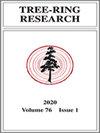Microelevational Differences Affect Longleaf Pine (Pinus palustris Mill.) Sensitivity to Tropical Cyclone Precipitation: A Case Study Using Lidar
IF 1.1
4区 农林科学
Q3 FORESTRY
引用次数: 4
Abstract
ABSTRACT Latewood ring widths of longleaf pine (Pinus palustris Mill.) growing on Carolina bay sand rims on the coastal plains of North Carolina are effective recorders of tropical cycone precipitation (TCP). Longleaf pine are hypothesized to be effective recorders of TCP because of their extensive lateral root structure that is exposed to enhanced soil moisture when TCP events raise the water table to root level, but this hypothesis has not been empirically tested. In this study, we used a combination of North Carolina Phase 1 LiDAR and high-precision georeferenced data to investigate the relationship between radial tree growth, TCP, and microelevation. Our findings suggest that the strength of correlations between latewood ring widths and TCP are positively correlated (p < 0.05) with tree elevation on Carolina bay sand rims, resulting in greater sensistivity of trees at higher elevations. These findings suggest that in some environments, microelevational differences (<1 m) may significantly affect climate/radial growth relationships and the use of high-resolution LiDAR technology may be an effective tool for better understanding the role of microtopography on radial growth patterns.微海拔差异对长叶松(Pinus palustris Mill.)对热带气旋降水敏感性的影响——以激光雷达为例
生长在北卡罗来纳州沿海平原卡罗莱纳湾沙缘的长叶松(Pinus palustris Mill.)的侧木年轮宽度是热带锥虫降水(TCP)的有效记录者。长叶松被认为是TCP的有效记录者,因为当TCP事件将地下水位升高到根部水平时,其广泛的侧根结构暴露在增强的土壤湿度下,但这一假设尚未得到实证检验。在这项研究中,我们结合北卡罗来纳州第一阶段激光雷达和高精度地理参考数据,研究了径向树木生长、TCP和微高程之间的关系。我们的研究结果表明,晚材环宽度和TCP之间的相关性强度与卡罗莱纳湾沙缘的树木海拔呈正相关(p<0.05),导致海拔较高的树木具有更大的敏感性。这些发现表明,在某些环境中,微海拔差异(<1米)可能会显著影响气候/径向生长关系,高分辨率激光雷达技术的使用可能是更好地理解微地形对径向生长模式作用的有效工具。
本文章由计算机程序翻译,如有差异,请以英文原文为准。
求助全文
约1分钟内获得全文
求助全文
来源期刊

Tree-Ring Research
农林科学-林学
CiteScore
2.40
自引率
12.50%
发文量
15
审稿时长
>36 weeks
期刊介绍:
Tree-Ring Research (TRR) is devoted to papers dealing with the growth rings of trees and the applications of tree-ring research in a wide variety of fields, including but not limited to archaeology, geology, ecology, hydrology, climatology, forestry, and botany. Papers involving research results, new techniques of data acquisition or analysis, and regional or subject-oriented reviews or syntheses are considered for publication.
Scientific papers usually fall into two main categories. Articles should not exceed 5000 words, or approximately 20 double-spaced typewritten pages, including tables, references, and an abstract of 200 words or fewer. All manuscripts submitted as Articles are reviewed by at least two referees. Research Reports, which are usually reviewed by at least one outside referee, should not exceed 1500 words or include more than two figures. Research Reports address technical developments, describe well-documented but preliminary research results, or present findings for which the Article format is not appropriate. Book or monograph Reviews of 500 words or less are also considered. Other categories of papers are occasionally published. All papers are published only in English. Abstracts of the Articles or Reports may be printed in other languages if supplied by the author(s) with English translations.
 求助内容:
求助内容: 应助结果提醒方式:
应助结果提醒方式:


